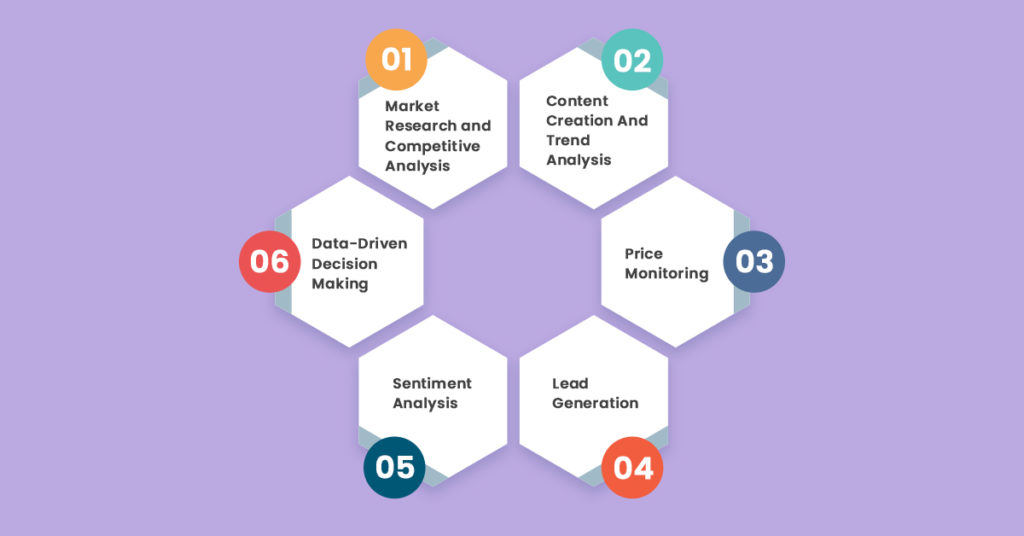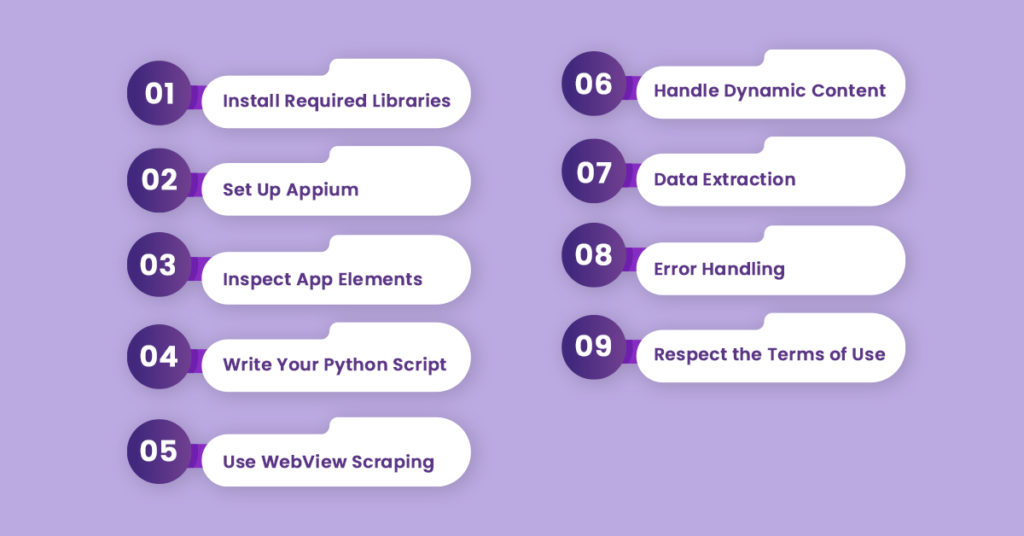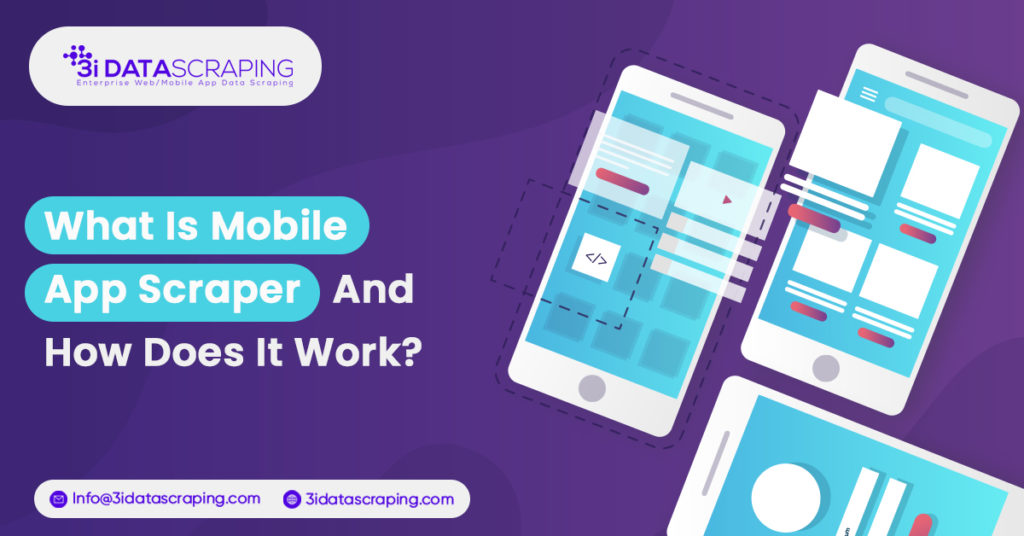What Is Mobile App Scraper And How Does It Work?
- October 3, 2023
Our achievements in the field of business digital transformation.









Introduction
Mobile applications have become integral to our daily lives in a world dominated by smartphones and tablets. From social networking and entertainment to productivity and e-commerce, there is an app for everything. But have you ever wondered how developers and businesses gather data from these apps to make informed decisions? This is where mobile app scrapers come into play.
Mobile app scrapers as digital spies, quietly working behind the scenes to collect valuable information from various mobile applications. They are crucial in market research, competitive analysis, and enhancing user experiences.
In this blog, we will learn what exactly Mobile App Scraper is, explore its benefits, and learn how to scrape mobile apps using Python. So, whether you are a curious user or an aspiring developer, this guide will provide insights that unveil the mystery behind these intriguing tools.
What Is a Mobile App Scraper?
A mobile app scraper is designed to gather information from mobile apps. These apps are mainly made for phones and tablets, which contain information. This information lets you learn about the market, check your competitors, or improve apps. This web scraping process includes rummaging through a mobile app’s user interface and extracting all the desired information like text, images, prices, ratings, reviews, and more. It entirely depends on your purpose and the app’s content.
Why Is Mobile App Scraping Necessary?

Mobile app scraping, also known as mobile app data extraction or scraping mobile apps, involves automatically collecting data from mobile applications. This practice has gained significance for several reasons:
1. Market Research and Competitive Analysis
Using a mobile app scraper is essential for doing good market research and looking at what your competitors are up to. By extracting information from other apps like your competitors, you can learn about what their apps do, user feedback, and how well they are performing. This information helps you determine what’s trending, see where things might improve, and make the right decision about your app. Looking at reviews, ratings, and what users say provides you with ideas about what people like and what needs to be changed for the better.
2. Content Creation And Trend Analysis
For content-centric apps or platforms, scraping is a valuable tool for content aggregation and trend analysis. Mobile apps can scrape relevant information and content from various sources, curating a diverse and engaging user experience. News aggregators, for example, can gather news articles from multiple websites to provide users with a comprehensive newsfeed. Trend analysis through scraping allows businesses to identify emerging topics, enabling them to create timely and relevant content that resonates with their audience.
3. Price Monitoring
Price Monitoring means monitoring how much things cost in mobile apps, like when you shop online. This helps businesses stay competitive by setting the right prices for their product and seeing what people like to buy. They can do this by collecting price information from different apps, which helps them change their prices swiftly to match the market’s demand.
4. Lead Generation
B2B apps can leverage mobile app scraping for lead generation. These apps can compile a database of potential clients or partners by extracting data from trustworthy sources, such as industry-specific websites or directories. This data can include contact information, company details, and other relevant insights. Lead generation through scraping streamlines identifying and reaching out to prospects, facilitating business growth.
5. Sentiment Analysis
Sentiment Analysis is extracting and analyzing the emotional tone of customer’s reviews, comments, and feedback within mobile apps. This helps companies and app makers know whether customers like their products. They can learn what’s good and what needs to be improved and see if users are happy. These reviews can also display what problems users often have, what they like, and how they generally feel. This helps improve apps, determine how to sell them and give good customer support.
6. Data-Driven Decision Making
Modern business strategies are increasingly reliant on concrete insights derived from data analysis. Mobile app scraping empowers businesses to gather comprehensive information from various apps, aiding market research and competitive analysis. Companies can gain deep insights into customer sentiment and preferences by collecting user reviews, ratings, and feedback. This real-time data allows businesses to understand their strengths and weaknesses and provides a clearer perspective on the competition’s offerings.
How to Scrape Mobile App Using Python?

Scraping mobile apps involves extracting data from their user interfaces, which can be tricky compared to web scraping due to the lack of standard HTML structure and the use of dynamic elements. However, there are tools and libraries available that can help you scrape mobile apps using Python. Here’s a general approach you can follow:
1. Install Required Libraries
You must install a few Python libraries to help you with app scraping. Some common ones include:
- Appium is a mobile automation framework that supports Android and iOS app scraping.
- Selenium: A web automation tool that can be used to interact with WebView elements within mobile apps.
- Beautiful Soup: A library for parsing HTML and XML documents.
Requests: For Making HTTP requests if needed.
2. Set Up Appium
Appium is commonly used for automating mobile app interactions. Install it using pip:
pip install Appium-Python-Client
You will also need the Appium server, which you can download from the Appium website.
Start the server before proceeding.
3. Inspect App Elements
Use the Appium inspector or similar tools to inspect the app’s UI elements and their identifiers. These identifiers are crucial for interacting with app elements.
4. Write Your Python Script
Use the Appium Python Client to write a script that interacts with the app. Here’s a basic example:
from Appium import webdriver
desired_caps = {
"platformName": "Android",
"deviceName": "YourDeviceName",
"appPackage": "com.example.app",
"appActivity": "com.example.app.MainActivity",
"noReset": True
}
driver = webdriver.Remote("http://localhost:4723/wd/hub", desired_caps)
# Interact with app elements using driver.find_element and related functions
driver.quit()
5. Use WebView Scraping
If the app uses WebView components to display content, you should use Selenium to interact with these components. This involves switching the context of the driver to the WebView context and then using Selenium to find elements.
6. Handle Dynamic Content
Many mobile apps load content dynamically. You might need to wait for elements to appear using explicit waits (`WebDriverWait` in Selenium) to avoid synchronization issues.
7. Data Extraction
Once you have located the desired elements, use the Appium or Selenium function to extract the data. You can also use Beautiful Soup for parsing if the content is HTML.
8. Error Handling
Due to potential UI changes, mobile app scraping can be more fragile than web scraping. Implement proper error handling to deal with unexpected scenarios.
9. Respect the Terms of Use
Always check the app’s terms of use before scraping. Some apps may prohibit scraping or have restrictions on data usage. Remember that mobile app scraping can be challenging due to differences in app structure, security mechanism, and dynamic content loading. Be prepared to invest time in trial and error, and always respect the app’s terms of use and privacy policies.
Final Thought
In conclusion, mobile app scrapers play a pivotal role in extracting hidden data from the growing universe of mobile applications. So, whether you are just curious about apps or want to become a developer, this guide helps you understand how these special tools work. As technology improves, using mobile app scrapers opens up many exciting opportunities. You can use data to make smart choices, enhance user’s experience for app users, and be part of the exciting world of innovation. If you still face problems in data scraping, you can take the help of leading mobile app scraping services.














What Will We Do Next?
- Our representative will contact you within 24 hours.
- We will collect all the necessary requirements from you.
- The team of analysts and developers will prepare estimation.
- We keep confidentiality with all our clients by signing NDA.





